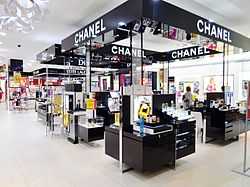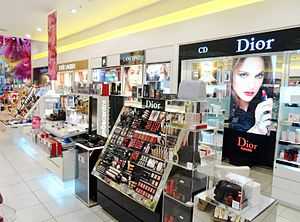Cosmetic industry

The cosmetic industry is dominated by a small number of multinational corporations that originated in the early 20th century, but the distribution and sale of cosmetics is spread among a wide range of different businesses. The largest cosmetic companies are The L'Oréal Group, The Procter & Gamble Company, Unilever, Shiseido Company, Limited and Estée Lauder Companies, Inc.[1] The market volume of the cosmetics industry in the US, Europe, and Japan is about EUR €70b per year, according to a 2005 publication.[2] In the United States, the cosmetic industry's size was US$42.8 billion in 2008.[3] The worldwide cosmetics and perfume industry currently generates an estimated annual turnover of US$170 billion (according to Eurostaf – May 2007). Europe is the leading market, representing approximately €63 billion.
France
Cosmetic sales in France reached €6.5 billion in 2006, according to FIPAR (Fédération des Industries de la Parfumerie – the French federation for the perfume industry).[4] France is another country in which the cosmetic industry plays an important role, both nationally and internationally. Most products with a label, "Made in France" are valued on the international market. According to data from 2008, the cosmetic industry has grown constantly in France for 40 consecutive years. In 2006, this industrial sector reached a record level of €6.5 billion. Famous cosmetic brands produced in France include Vichy, Yves Saint Laurent, Yves Rocher and many others.

Germany
In Germany, the cosmetic industry generated €12.6 billion of retail sales in 2008,[5] which makes the German cosmetic industry the third largest in the world, after Japan and the United States. It has been shown that in Germany this industry grew nearly 5 percent in one year, from 2007 to 2008. German exports in this industry reached €5.8 billion in 2008, whereas imports of cosmetics totaled €3 billion.[5] The main countries that export cosmetics to Germany are France, Switzerland, the United States and Italy, and they mainly consist of makeup and fragrances or perfumes for women.
Italy
The Italian cosmetic industry is also an important player in the European cosmetic market. Although not as large as in other European countries, the cosmetic industry in Italy was estimated to reach €9 billion in 2007.[6] The Italian cosmetic industry is however dominated by hair and body products and not makeup as in many other European countries. In Italy, hair and body products make up approximately 30% of the cosmetic market. Makeup and facial care, however, are the most common cosmetic products exported to the United States.
Fashion designer collaboration
Due to the popularity of cosmetics, especially fragrances and perfumes, many designers who are not necessarily involved in the cosmetic industry came up with different perfumes carrying their names. Moreover, some actors and singers have their own perfume line (such as Celine Dion). Designer perfumes are, like any other designer products, the most expensive in the industry as the consumer pays not only for the product but also for the brand. Famous Italian fragrances are produced by Giorgio Armani, Dolce and Gabbana, and others.
Marketing
The cosmetic industry worldwide seems to be continuously developing, now more than ever with the advent of the Internet companies. Many famous companies sell their cosmetic products online also in countries in which they do not have representatives.
Research on the email marketing of cosmetics to consumers suggests they are goal-oriented with email content that is seen as useful, motivating recipients to visit a store to test the cosmetics or talk to sales representatives. Useful content included special sales offerings and new product information rather than information about makeup trends.[7]
References
- ↑ Top 100 Cosmetic Manufacturers
- ↑ Günther Schneider, Sven Gohla, Jörg Schreiber, Waltraud Kaden, Uwe Schönrock, Hartmut Schmidt-Lewerkühne, Annegret Kuschel, Xenia Petsitis, Wolfgang Pape, Hellmut Ippen and Walter Diembeck "Skin Cosmetics" in Ullmann's Encyclopedia of Industrial Chemistry 2005, Wiley-VCH, Weinheim. doi:10.1002/14356007.a24_219
- ↑ "Pell Research". Cosmetics Manufacturing Report.
- ↑ "France continues to lead the way in cosmetics". Retrieved 2010-08-04.
- ↑ 5.0 5.1 "Cosmetic Industry". Retrieved 2010-08-04.
- ↑ "Cosmetics – Europe (Italy) 2008 Marketing Research". Retrieved 2010-08-04.
- ↑ Martin Brett A. S., Joel , Durme Van, Raulas Mika, Merisavo Marko (2003). "E-mail Marketing: Exploratory Insights from Finland" (PDF). Journal of Advertising Research 43 (3): 293–300. doi:10.1017/s0021849903030265.
Further reading
- Winter, Ruth (2005) [2005]. A Consumer's Dictionary of Cosmetic Ingredients: Complete Information About the Harmful and Desirable Ingredients in Cosmetics (Paperback). US: Three Rivers Press. ISBN 1-4000-5233-5.
- Begoun, Paula (2003) [2003]. Don't Go to the Cosmetics Counter Without Me(Paperback). US: Beginning Press. ISBN 1-877988-30-8.
- Carrasco, Francisco (2009) [2009]. Diccionario de Ingredientes Cosmeticos(Paperback) (in Spanish). Spain: www.imagenpersonal.net. ISBN 978-84-613-4979-1.
- "Cosmetics as a Feature of the Extended Human Phenotype: Modulation of the Perception of Biologically Important Facial Signals". Plos One. Retrieved 2011-10-23.
- "Makeup Makes Women Appear More Competent: Study". The New York Times. 2011-10-12.
| ||||||||||||||||||||||||||||||||||||||